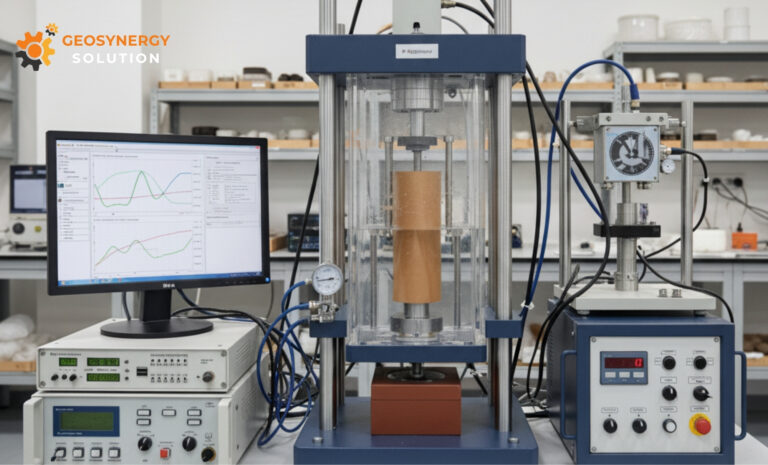
Importance of Triaxial Cyclic Testing in Geotechnical Engineering
The Triaxial Cyclic Test in geotechnical engineering plays a vital role in evaluating soil behavior under cyclic or repeated loading conditions. This test simulates the effects of dynamic forces, such as earthquakes, traffic loads, and vibrations, on soil and rock samples. By understanding how soil reacts to these stresses, engineers can design safer and more reliable foundations, embankments, and structures. Moreover, it provides essential data for developing accurate soil models and ensuring long-term stability in various projects.
What Is a Triaxial Cyclic Test?
A Triaxial Cyclic Test measures the deformation, pore pressure buildup, and strength of soil when subjected to cyclic loading. It uses a cylindrical soil specimen enclosed in a chamber, where controlled stress and strain are applied.
Furthermore, this method allows engineers to study the following parameters:
Soil stiffness and damping characteristics
Liquefaction potential in saturated sandy soils
Deformation behavior under repetitive loading
As a result, the data obtained help engineers predict how soil will perform when exposed to real-world cyclic or vibrational forces.
Why It Matters in Geotechnical Engineering
In geotechnical projects, understanding cyclic behavior is crucial, especially for earthquake-prone areas and dynamic load environments. The Triaxial Cyclic Test provides data that help engineers:
Predict soil performance under dynamic loads
Prevent structural damage during earthquakes
Design resilient and stable foundations
Improve the accuracy of geotechnical models
In addition, this test helps optimize designs by identifying the limits of soil strength under repetitive stress. Consequently, engineers can enhance both safety and efficiency in infrastructure projects.
Related article: Recomended Triaxial Cyclic Test In Indonesia
Methods Used in Triaxial Cyclic Testing
Several methods are used depending on the project requirements. The most common include:
Stress-controlled testing, which applies cyclic deviator stress to study soil response under different stress amplitudes.
Strain-controlled testing, which applies cyclic strain to observe changes in pore pressure and stiffness degradation.
Moreover, these tests are conducted using advanced triaxial testing systems equipped with digital sensors to ensure accuracy, consistency, and repeatability. Therefore, they provide high-quality data that can be relied upon for engineering analysis and design.
Applications of Triaxial Cyclic Tests
The Triaxial Cyclic Test is widely applied in many geotechnical and civil engineering fields, including:
Earthquake engineering and liquefaction analysis
Pavement and foundation design
Offshore and port structure stability assessments
Research on soil improvement and reinforcement
Additionally, it plays an important role in evaluating soil properties for renewable energy foundations, underground storage, and slope stability studies. Finally, by integrating these results into design models, engineers can ensure that structures remain safe, durable, and sustainable over time.
The Triaxial Cyclic Test is a vital component of modern geotechnical investigations. It helps engineers understand how soil behaves under repetitive stress, ensuring that structures can withstand dynamic and seismic forces. With accurate test data and reliable interpretation, construction safety, sustainability, and long-term performance can be significantly improved.

